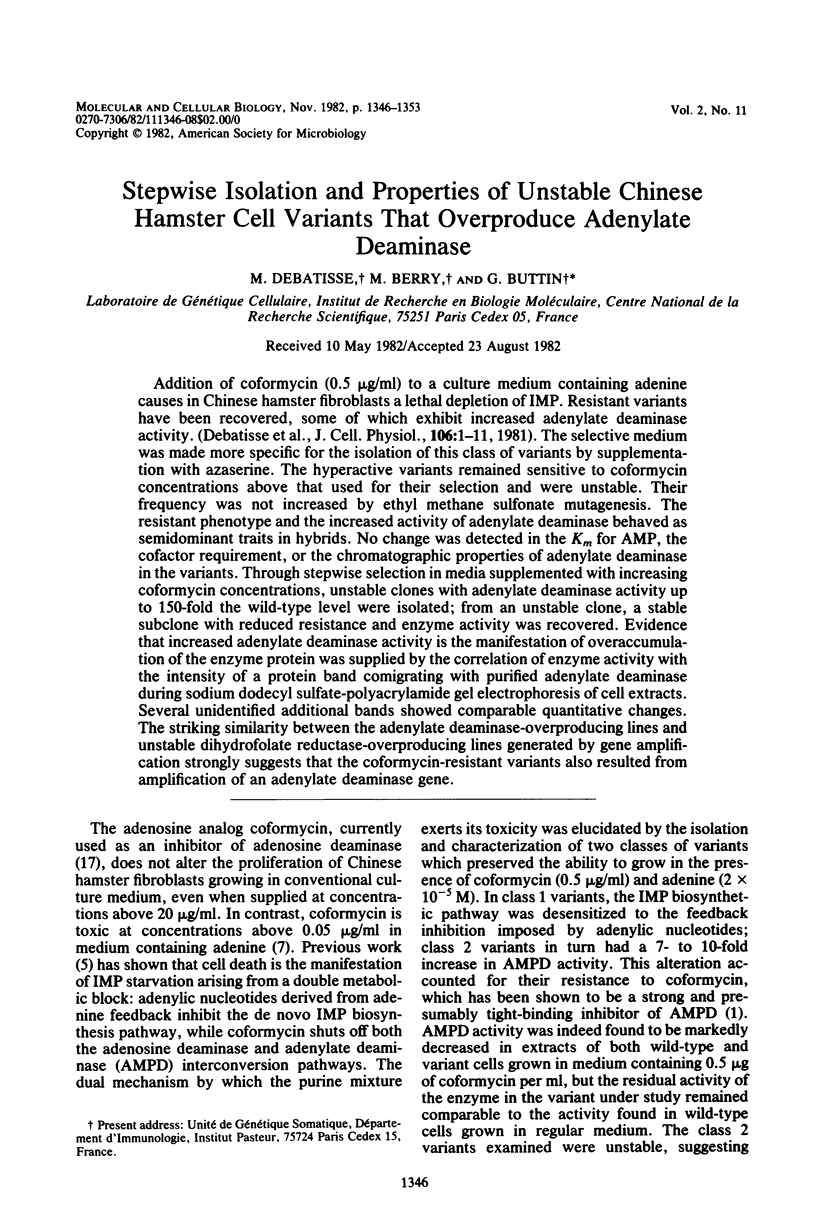Stepwise isolation and properties of unstable Chinese hamster cell variants that overproduce adenylate deaminase (original) (raw)
Abstract
Addition of coformycin (0.5 microgram/ml) to a culture medium containing adenine causes in Chinese hamster fibroblasts a lethal depletion of IMP. Resistant variants have been recovered, some of which exhibit increased adenylate deaminase activity. (Debatisse et al., J. Cell. Physiol., 106:1-11, 1981). The selective medium was made more specific for the isolation of this class of variants by supplementation with azaserine. The hyperactive variants remained sensitive to coformycin concentrations above that used for their selection and were unstable. Their frequency was not increased by ethyl methane sulfonate mutagenesis. The resistant phenotype and the increased activity of adenylate deaminase behaved as semidominant traits in hybrids. No change was detected in the Km for AMP, the cofactor requirement, or the chromatographic properties of adenylate deaminase in the variants. Through stepwise selection in media supplemented with increasing coformycin concentrations, unstable clones with adenylate deaminase activity up to 150-fold the wild-type level were isolated; from an unstable clone, a stable subclone with reduced resistance and enzyme activity was recovered. Evidence that increased adenylate deaminase activity is the manifestation of overaccumulation of the enzyme protein was supplied by the correlation of enzyme activity with the intensity of a protein band comigrating with purified adenylate deaminase during sodium dodecyl sulfate-polyacrylamide gel electrophoresis of cell extracts. Several unidentified additional bands showed comparable quantitative changes. The striking similarity between the adenylate deaminase-overproducing lines and unstable dihydrofolate reductase-overproducing lines generated by gene amplification strongly suggests that the coformycin-resistant variants also resulted from amplification of an adenylate deaminase gene.

Images in this article
Selected References
These references are in PubMed. This may not be the complete list of references from this article.
- Agarwal R. P., Parks R. E. Potent inhibition of muscle 5'-AMP deaminase by the nucleoside antibiotics coformycin and deoxycoformycin. Biochem Pharmacol. 1977 Apr 1;26(7):663–666. doi: 10.1016/0006-2952(77)90046-6. [DOI] [PubMed] [Google Scholar]
- Beach L. R., Palmiter R. D. Amplification of the metallothionein-I gene in cadmium-resistant mouse cells. Proc Natl Acad Sci U S A. 1981 Apr;78(4):2110–2114. doi: 10.1073/pnas.78.4.2110. [DOI] [PMC free article] [PubMed] [Google Scholar]
- Debatisse M., Berry M., Buttin G. The potentiation of adenine toxicity to Chinese hamster cells by coformycin: suppression in mutants with altered regulation of purine biosynthesis or increased adenylate-deaminase activity. J Cell Physiol. 1981 Jan;106(1):1–11. doi: 10.1002/jcp.1041060102. [DOI] [PubMed] [Google Scholar]
- Debatisse M., Buttin G. The control of cell proliferation by preformed purines: a genetic study. I. Isolation and preliminary characterization of Chinese hamster lines with single or multiple defects in purine "salvage" pathways. Somatic Cell Genet. 1977 Sep;3(5):497–511. doi: 10.1007/BF01539121. [DOI] [PubMed] [Google Scholar]
- Debatisse M., Buttin G. The control of cell proliferation by preformed purines: a genetic study. II. Pleiotropic manifestations and mechanism of a control exerted by adenylic purines on PRPP synthesis. Somatic Cell Genet. 1977 Sep;3(5):513–527. doi: 10.1007/BF01539122. [DOI] [PubMed] [Google Scholar]
- Dechamps M., de Saint-Vincent B. R., Evrard C., Sassi M., Buttin G. Studies on 1-beta-D-arabinofuranosyl-cytosine (Ara-C) resistant mutants of Chinese hamster fibroblasts. II. High resistance to Ara-C as a genetic marker for cellular hybridization. Exp Cell Res. 1974 Jun;86(2):269–279. doi: 10.1016/0014-4827(74)90713-7. [DOI] [PubMed] [Google Scholar]
- Kaufman R. J., Brown P. C., Schimke R. T. Amplified dihydrofolate reductase genes in unstably methotrexate-resistant cells are associated with double minute chromosomes. Proc Natl Acad Sci U S A. 1979 Nov;76(11):5669–5673. doi: 10.1073/pnas.76.11.5669. [DOI] [PMC free article] [PubMed] [Google Scholar]
- Kaufman R. J., Brown P. C., Schimke R. T. Loss and stabilization of amplified dihydrofolate reductase genes in mouse sarcoma S-180 cell lines. Mol Cell Biol. 1981 Dec;1(12):1084–1093. doi: 10.1128/mcb.1.12.1084. [DOI] [PMC free article] [PubMed] [Google Scholar]
- Kempe T. D., Swyryd E. A., Bruist M., Stark G. R. Stable mutants of mammalian cells that overproduce the first three enzymes of pyrimidine nucleotide biosynthesis. Cell. 1976 Dec;9(4 Pt 1):541–550. doi: 10.1016/0092-8674(76)90036-2. [DOI] [PubMed] [Google Scholar]
- Laemmli U. K. Cleavage of structural proteins during the assembly of the head of bacteriophage T4. Nature. 1970 Aug 15;227(5259):680–685. doi: 10.1038/227680a0. [DOI] [PubMed] [Google Scholar]
- Nunberg J. H., Kaufman R. J., Schimke R. T., Urlaub G., Chasin L. A. Amplified dihydrofolate reductase genes are localized to a homogeneously staining region of a single chromosome in a methotrexate-resistant Chinese hamster ovary cell line. Proc Natl Acad Sci U S A. 1978 Nov;75(11):5553–5556. doi: 10.1073/pnas.75.11.5553. [DOI] [PMC free article] [PubMed] [Google Scholar]
- Ranieri-Raggi M., Raggi A. Effects of storage on activity and subunit structure of rabbit skeletal-muscle AMP deaminase. Biochem J. 1980 Aug 1;189(2):367–368. doi: 10.1042/bj1890367. [DOI] [PMC free article] [PubMed] [Google Scholar]
- Sawa T., Fukagawa Y., Homma I., Takeuchi T., Umezawa H. Mode of inhibition of coformycin on adenosine deaminase. J Antibiot (Tokyo) 1967 Jul;20(4):227–231. [PubMed] [Google Scholar]
- Schimke R. T., Kaufman R. J., Alt F. W., Kellems R. F. Gene amplification and drug resistance in cultured murine cells. Science. 1978 Dec 8;202(4372):1051–1055. doi: 10.1126/science.715457. [DOI] [PubMed] [Google Scholar]
- Smiley K. L., Jr, Berry A. J., Suelter C. H. An improved purification, crystallization, and some properties of rabbit muscle 5'-adenylic acid deaminase. J Biol Chem. 1967 May 25;242(10):2502–2506. [PubMed] [Google Scholar]
- Vincent B. R., Buttin G. Studies on 1-beta-D-arabinofuranosyl cytosine-resistant mutants of Chinese hamster fibroblasts: III. Joint resistance to arabinofuranosyl cytosine and to excess thymidine--a semidominant manifestation of deoxycytidine triphosphate pool expansion. Somatic Cell Genet. 1979 Jan;5(1):67–82. doi: 10.1007/BF01538787. [DOI] [PubMed] [Google Scholar]
- Wahl G. M., Padgett R. A., Stark G. R. Gene amplification causes overproduction of the first three enzymes of UMP synthesis in N-(phosphonacetyl)-L-aspartate-resistant hamster cells. J Biol Chem. 1979 Sep 10;254(17):8679–8689. [PubMed] [Google Scholar]
- de Saint-Vincent B. R., Buttin G. Studies on 1-beta-D-arabinofuranosyl-cytosine-resistant mutants of Chinese-hamster fibroblasts. A mitochondrial deoxycytidine kinase devoid of activity on arabino-cytosine. Eur J Biochem. 1973 Sep 3;37(3):481–488. doi: 10.1111/j.1432-1033.1973.tb03009.x. [DOI] [PubMed] [Google Scholar]